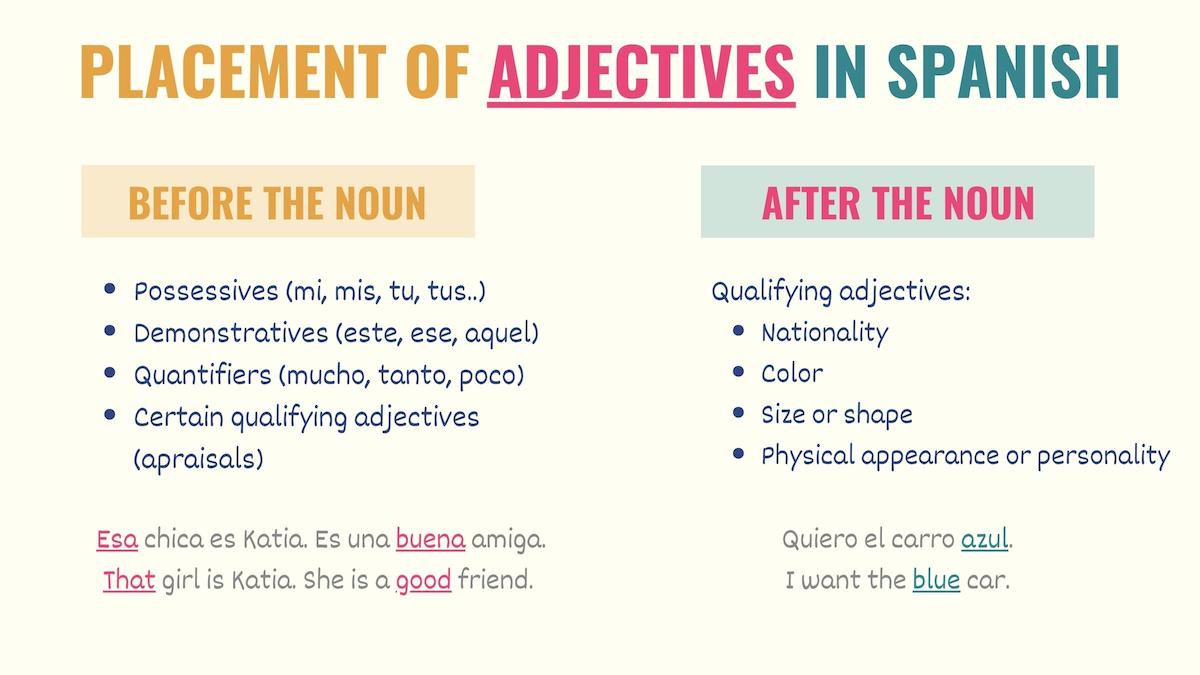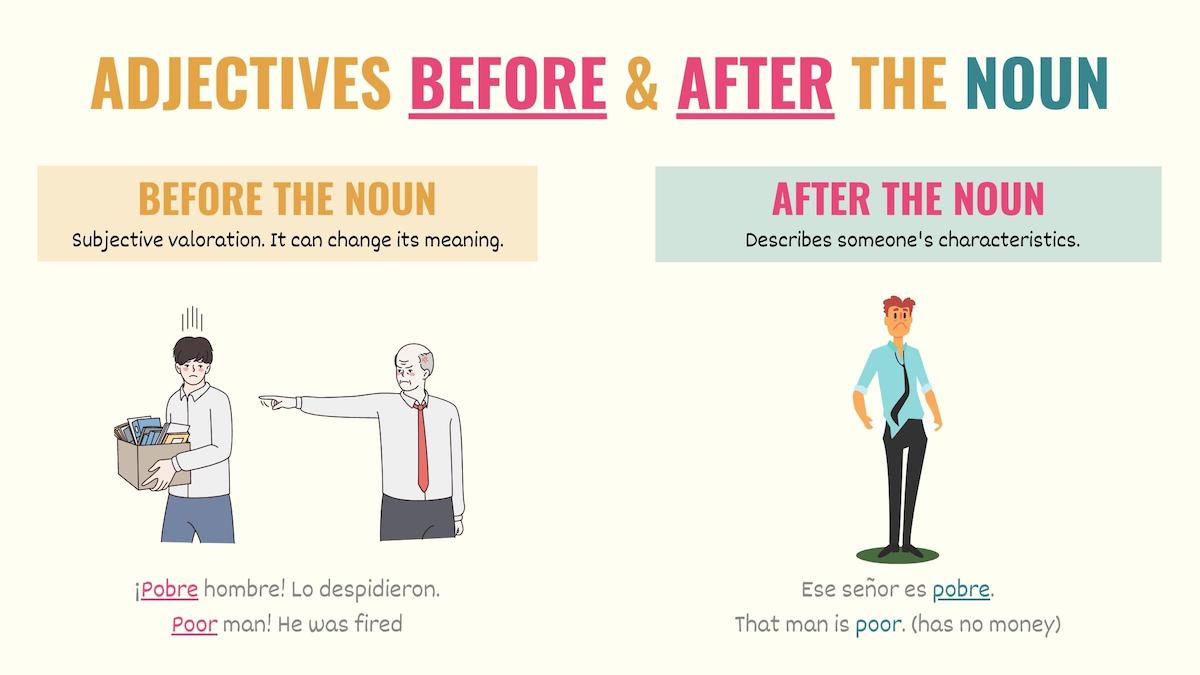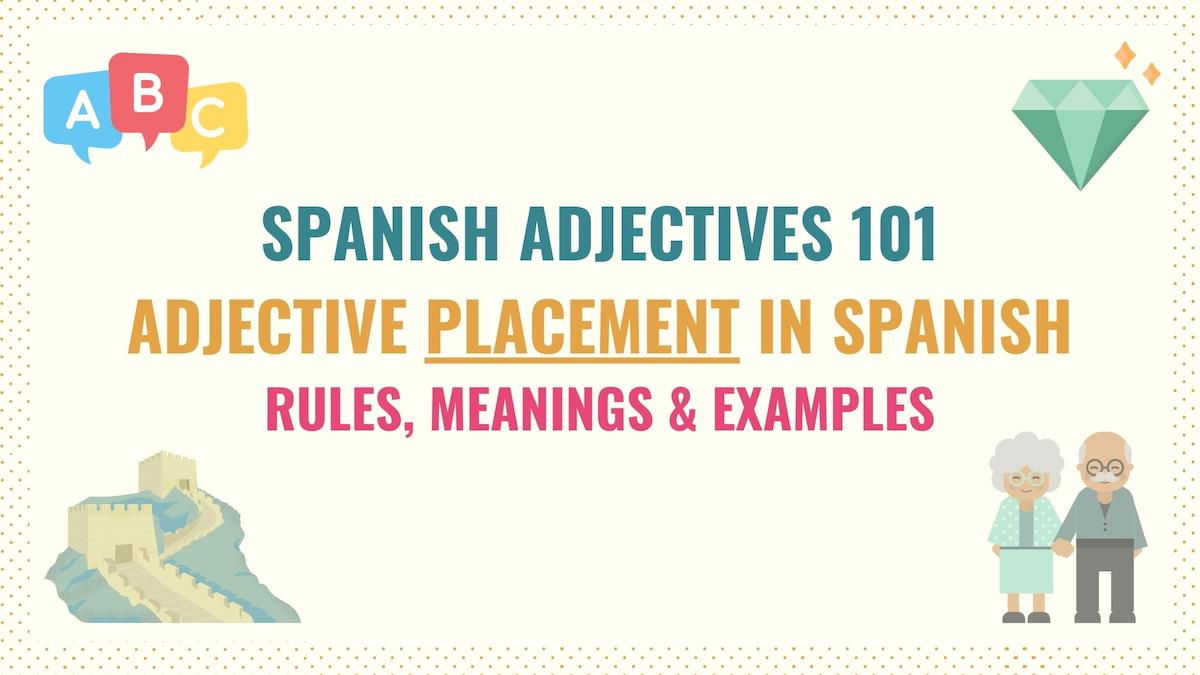Spanish adjectives are an essential part of speech that offers supplementary information about nouns. Although these words may seem straightforward, many learners need help understanding the rules for adjective placement in Spanish.
Since placing adjectives before or after the noun can affect the meaning of your sentences, in this guide, we’ll go over:
- Where Do Adjectives Go in Spanish
- Adjectives that Come Before a Noun
- Key Points
- Additional Resources: Next Steps
- Downloadable PDF Cheat Sheet
Where Do You Place Adjectives in Spanish?
In Spanish, the position of adjectives depends on the type of information they provide.
For the most part, qualifying or descriptive adjectives in Spanish come after the noun. As its name suggests, these types of adjectives describe a noun’s qualities or characteristics, including size, nationality, personality, physical appearance, shape, and more.
Check these sentences:
[Noun] + (verb) + [adjective]
Emilia tiene un celular nuevo.
Emilia has a new phone.
Esas chicas son alemanas.
Those girls are German.
La casa de tus papás es grande.
Your parent’s house is big.
El perro negro te mordió.
The black dog bit you.
In Spanish, we position an adjective immediately following the noun to distinguish a particular person or thing within a group based on its qualities. For instance, the last example allows us to identify the dog that bit you.
However, if you’re listing someone or something’s qualities, you can use a linking verb, such as ser, estar or parecer, between the Spanish adjective and noun.
La niña está triste.
The girl is sad.
Notice that you can also use adverbs in Spanish to intensify the qualities described by an adjective. In those types of sentences, adjectives come after the adverb:
[Noun] + [verb] + [adverb] + [adjective]
Mis vecinos son muy altos.
My neighbors are very tall.
Esas galletas no son tan buenas como las tuyas.
Those cookies are not as good as yours.

Take Note: According to the adjective agreement rules in Spanish, these words must agree in gender and number with the noun they accompany.
Spanish Adjectives Before Nouns
As mentioned above, the information delivered by adjectives determines whether these words come before or after a noun.
In Spanish, the following adjectives always come before nouns:
- Possessive adjectives (mi, mis, tu, tus, etc)
- Quantifiers (mucho, poco, tanto)
- Demonstrative adjectives (este, ese, aquel, etc)
Unlike qualifying adjectives, these words do not describe attributes; they rather refer to amounts, proximity, or possession. Check these examples:
Esa casa es azul.
That house is blue.
Su mamá es doctora.
Her mom is a doctor.
Johan tiene muchas amigas.
Johan has many friends.
Take Note: These words are also known as Spanish determiners (or limiting adjectives) because the information they provide narrows down or specifies the noun they modify.
In Spanish, qualifying adjectives can also go before the noun. However, when doing this we stress the noun’s characteristics and convey a subjective appraisal.
Eres una buena amiga.
You’re a superb friend.
Es un buen restaurante, pero es caro.
It’s a good restaurant, but it’s expensive.
Take Note: With some adjectives that are placed before a singular masculine noun, we must drop the ‘o’ or ‘e’. Examples of words that follow this pattern are: bueno, mal, grande, algún, uno, ningún, primero, and tercero.
Change in meaning with placement in sentences
For the most part, a descriptive adjective that is placed before the noun maintains its meaning. However, the meaning of some adjectives changes depending on their position in the sentence.
| Adjective | Before | After |
|---|---|---|
| Antiguo | Previous / Former | Old |
| Cierto | Certain / One | True / Right |
| Gran / Grande | Great | Big |
| Mismo | Same | Self |
| Raro | Rare | Strange / Odd |
| Pobre | Poor / Unfortunate | Poor |
| Simple | Mere | Simple / Easy |
| Solo | Single / One | Alone / Lonely |
| Único | Only | Unique |
| Viejo | Former / Previous / Old | Old |
The table above shows how the Spanish adjective takes on a completely different meaning (shown in English) based on whether it is placed before or after the noun.
Here are some examples:
Cynthia es una vieja amiga mía.
Cynthia is an old friend of mine.
Nuestro coche es muy viejo.
Our car is very old.
Es una gran oportunidad.
It’s a great opportunity.
La casa grande es de Lucas.
The big house is Luca’s.

Key Points
Spanish adjectives are crucial to forming descriptive and clear sentences. However, you need to make sure you put them in the correct order. Here are some key points you should keep in mind:
- The position of these words depends on the information they provide.
- Limiting adjectives (also called determiners) always come before the noun.
- Qualifying or descriptive adjectives usually go after the noun.
- Spanish adverbs are placed before adjectives, and they help you intensify its qualities.
- Descriptive adjectives can go before nouns when providing an appraisal about a person or thing.
- Certain qualifying words change their meaning based on their position in the sentence.
Additional Resources for Spanish Adjective Placement
Now that you know the Spanish adjective placement rules, your next step is understanding noun and adjective agreement. Also, to increase your vocabulary, you should learn the most common adjectives in Spanish.
Finally, you must get familiar with determiner words (possessives, demonstratives, etc). As limiting adjectives, these words always come before a noun and provide information that can help you specify something or someone.
Watch the Video Lesson
Watch the Spanish Immersion Lesson!
You can watch this video on Adjective Placement in Spanish if you’re looking to practice your listening comprehension. You can also watch the English explanation in case you missed anything in the immersion lesson.
Download the Adjective Placement Spanish Grammar PDF
Just like in English, Spanish grammar is full of its own rules unique to the language. Adjective placement is important and can significantly change that sentence’s meaning. So, I’ve created a PDF you can download with the key points, notes and graphics for this topic so you can use Spanish adjectives accurately and with confidence.



